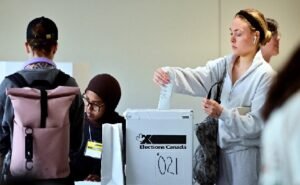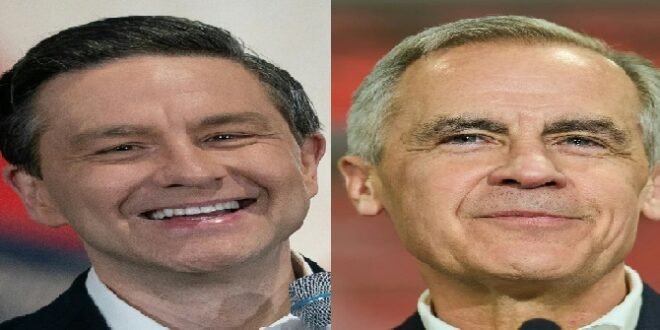30-04-2025
OTTAWA: Canadians wait to see which candidate will lead their country, and tackle US tariffs and the high cost of living, as the federal election draws to a close.
Polls first closed at 8.30pm Newfoundland Time (23:00 GMT) in the far east of Canada and will continue westward until the last poll ends at 7pm Pacific Time (02:00 GMT).
 Ahead of the election, polls showed the Liberals leading with nearly 43 percent, above Conservatives at just more than 39 percent, according to media. The New Democratic Party was polling third at about 9 percent, followed by Bloc Quebecois at 6 percent. The Conservatives will be happy, the media has projected a win for them in Newfoundland’s Long Range Mountains riding, which had been held by the Liberal Party.
Ahead of the election, polls showed the Liberals leading with nearly 43 percent, above Conservatives at just more than 39 percent, according to media. The New Democratic Party was polling third at about 9 percent, followed by Bloc Quebecois at 6 percent. The Conservatives will be happy, the media has projected a win for them in Newfoundland’s Long Range Mountains riding, which had been held by the Liberal Party.
If that performance is repeated elsewhere than it would mean the Conservatives have defied the polls, and may be on course for a stronger performance than expected but again, a reminder, it is still very early in the night voting continues across central and western Canada.
The Liberals currently have nine projected seats, while the Conservatives have three.
Politicians from Canada’s Liberal and Conservative parties have been speaking to the Canadian Broadcasting Corporation (CBC).
Liberal MP Arif Virani, from Toronto’s Parkdale-High Park riding, said that “there’s a lot of cautious optimism out there” about today’s results.
Virani, who is not running for re-election, said voters are “gravitating” towards Liberal leader Carney and his plan to take on Trump,” who Virani said is posing “an existential challenge” for Canada.
Meanwhile, Jason Kenney, the former premier of Alberta and a former Conservative cabinet minister, said that Canadians are looking for change when it comes to “taking on Trump right now” and “that’s where Poilievre wanted to steer Canadians,” Kenney said.
The Liberals will be hoping for a repeat of their 2021 performance in the eastern provinces, where voting has already ended in Canada.
 The Liberals won a majority of the districts in all four provinces, including a clean sweep of the four ridings in Prince Edward Island.
The Liberals won a majority of the districts in all four provinces, including a clean sweep of the four ridings in Prince Edward Island.
In Newfoundland and Labrador, they took six districts to the Conservatives one, while in Nova Scotia, the Liberals won eight districts, and three went to the Conservatives. In New Brunswick, the results were a little closer, with the Liberals winning six ridings to the Conservatives’ four.
No other party won any seats in the four provinces.
Vote counting has started in these provinces, but it is still much too early to get a clear idea of the final results.
As leader of the Conservative Party, Poilievre, a longtime Member of Parliament, tapped into popular discontent with Trudeau and the Liberals, hitting them on cost-of-living issues, immigration, and hot-button cultural topics.
For a while, it seemed to be working. A moribund Trudeau sank in the polls, and Poilievre looked to be on the edge of a smashing victory, with a mid-January poll finding him ahead by up to 26 points but that lead has all but evaporated amid doubts that the Conservatives have what it takes to stand up to their counterparts in the US amid an escalating trade war that has angered many Canadians.
That’s the provinces of Nova Scotia, New Brunswick and Prince Edward Island. There’s still another two hours to go until voting ends in the vastly more populous provinces of Ontario, Quebec and Alberta. Soon after that, we should get a good idea of how well each party has done on a national level. (Int’l News Desk)
 Pressmediaofindia
Pressmediaofindia




